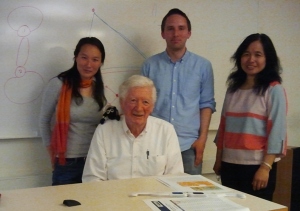
Here I am at one of the beamlines at Petra synchrotron, at DESY, Hamburg. The tube behind me is where the beam comes from… scary!
Albert here! Some of you may recognise me from Haggis’ Twitter feed and from Haggis’ 2011 New Year’s post (along with the rest of our family!). Last week I was in Hamburg at PETRA III, a synchrotron at DESY. After some successful measurements there, I made the short hop across the Baltic Sea to the lovely city of Stockholm, for the 4th International School on Crystal Topology.
First I should say a little about what I do. I’m interested in chemistry, especially materials called Metal-Organic Frameworks (MOFs).

An example of one of the first MOFs, MOF-5. Chemists use rigid organic struts (top left) to link clusters of metal atoms (in this case four zinc atoms, bottom left) to build open framework-like materials (right).
These are a new type of material made from clusters of metal and oxygen atoms which are linked together by long rigid linkers – think of it kind of like a climbing frame. These materials are interesting as they might help to combat climate change by sieving out CO2 in a process called Carbon Capture and Storage (CCS made it into the Oxford English Dictionary recently!).
But what does this have to do with topology? Chemists simplify the structures of MOFs down to a series of rods (edges) and nodes where these rods meet (vertices) – the simplified structures are mathematical graphs. We can then see how the structure is connected together as a network, without unnecessary molecular clutter. As chemists we want a way to classify the networks of our materials for two reasons. Firstly, so we can see if similar networks have been made before by other researchers, and secondly to help us design new materials. We might, for example, find that a certain network is really good at storing CO2; using a linker molecule which holds onto CO2 really well and the right topology to form our target network, we could make a new material which is even better at capturing CO2. To classify our networks we need to use graph theory.

Charlotte Bonneau (left), Michael O’Keeffe (middle left), the person I hitched a lift to Stockholm with (middle right), Xiaodong Zou (right)
However chemists are not normally trained in graph theory, so this was the aim of the Stockholm school. The school was taught by Prof. Michael O’Keeffe (emeritus Regents’ Professor at Arizona State University), who taught us about the mathematical ideas necessary to deconstruct a crystalline network, and Dr Charlotte Bonneau (currently a full time mother to the adorable Leonie), who focussed more on the use of software to analyse crystal structures, such as systre and Topos.
During Mike’s lectures we were told about the graph isomorphism problem of determining whether two finite graphs have the same connectivity. This is of importance to chemists, as we want to be able to compare our networks to see if they have been reported before! Graph isomorphism is also a specific example of one of the million dollar maths problems, P versus NP, which asks whether every problem for which a solution can be quickly checked, may also be quickly solved by a computer. One of Mike’s collaborators, Dr Olaf Delgado-Friedrichs, has attempted to address the graph isomorphism problem in the program systre. systre uses a barycentric method to raise the symmetry of a collection of atoms in a graph to the highest symmetry representation. The barycentric representation is effectively like replacing all the edges in the graph with springs and these pulling the vertices to their weighted average positions. Although systre is able to classify most graphs, it is unable to deal with graphs where applying the barycentric approach causes two nodes to collapse into one another (a so-called collision – see picture). So unfortunately, it’s not a complete solution to P versus NP.

A graph showing a collision. When you put this into a baricentric representation, the two red nodes collapse into one another. Back to the drawing board for a solution to the graph isomorphism problem then…
The rest of the course was full of lots of useful information which will help in making new materials and further classifying old ones. The course as a whole was a lot of fun and it was great to meet such a friendly bunch of people! That’s it from me for the minute, but look out for more photos of me on Twitter at exciting scientific/mathematical locations – Albert out.

Posted by golden ration in art on July 4, 2012 at 1:48 am
I arrived at your site by accident. I’m glad that I did.
Posted by My new geek clock « Knot your average sheep… on October 23, 2012 at 5:52 pm
[…] loving this new addition to my flat: a geeky maths/science clock. It was designed by myself and Albert and then built by Kate Wharmby, who is also very talented at making stained glass and has made me a […]
Posted by Vinoy Varghese on January 1, 2016 at 5:47 am
plzzzz tell me where can i get this clock to buy it ???? email me the links where i can buy the above clock online